What Is VR App Development Cost in 2025: Main Price Factors
Updated 21 Jun 2024
20 Min
4639 Views
What’s VR app development cost? Immersive technologies still alter people’s minds and more businesses from completely different fields want to create an app with VR functionality. Besides being trendy, virtual reality can significantly aid many industries by enabling immersive trainings, realistic simulations, simplified virtual collaborations and more.
In this article, you’ll discover the cost of VR app development, most vibrant VR application success examples and their pricing, and how to monetize your VR solution.
Factors Affecting Virtual Reality App Development Cost
Let’s define what VR app development cost exactly consists of and what factors have to be assessed primarily. Here are 5 main factors you should consider:
Complexity and scope
More detailed and intricate applications will definitely require more development time, resources, finances, and expertise. For example, if you plan to build a VR application and include sophisticated functionality like detailed 3D models, and multi-layered user interactions, this will add to the complexity and raise the cost of the overall VR solution.
As a result, the price range for developing a VR app with ranges from $20,000 - $150,000. However the VR app with extensive functionality set starts from $350,000 - $350,000+.
Platform
The platform for which the app is being developed also significantly affects the cost. High-end platforms like Apple Vision Pro or PC-tethered systems like Oculus Rift S require more complex development and software experts with narrower and niche expertise. At the same time, simpler mobile VR platforms like Google Cardboards or Samsung Gear VR will definitely require less spending and effort. Different platforms also have varied requirements and optimization needs, impacting development time and expenses.
- Mobile VR (e.g., Google Cardboard). The cost for mobile app development services for VR cost is usually lower, comparing to PC-tethered VR or standalone VR headsets ranging from $3,000 to $15,000. This is implied by simplicity of hardware, limited interactivity, and lower graphics requirements
- Standalone VR Headsets (e.g.,Oculus Quest). Vr app development pricing for this types of headsets starts from $15,000 to $50,000. The standalone headsets have more interactivity levels, support advanced graphics and have more potential for advanced functionality integration which definitely affects the price of VR development.
- PC-Tethered VR (e.g., Oculus Rift S). PC tethered VR app development cost ranges from $30,000 - $100,000. Such high-end hardware offers more complex and realistic VR experiences requiring extensive programming and design work. Apart from this, apps for PC-tethered VR require significant optimization efforts for smooth performance on PCs adding to the overall VR app cost.
Below, examine the main features of the popular VR platforms and their development time.
Note: This time estimation is approximate and may heavily depend on your unique case regarding VR app requirements, feature set, and specific demands
| Feature | Google Cardboard | Apple Vision Pro | Oculus Rift S | PlayStation VR |
Basic navigation | 80-160 hours | 200-240 hours | 180-220 hours | 160-200 hours |
Simple Interaction | 120-200 hours | 240-280 hours | 200-260 hours | 180-240 hours |
3D model viewing | 160-240 hours | 280-320 hours | 240-300 hours | 220-280 hours |
Audio integration | 80-160 hours | 180-220 hours | 160-200 hours | 140-180 hours |
Basic UI/UX design | 80-120 hours | 160-200 hours | 140-180 hours | 120-160 hours |
Advanced graphics | 400-480 hours | 360-420 hours | 320-400 hours | |
Complex interactions | 200-280 hours | 480-560 hours | 420-480 hours | 400-460 hours |
Multiplayer/networking | 480-600 hours | 420-520 hours | 400-500 hours | |
Platform optimization | 80-120 hours | 200-240 hours | 180-220 hours | 160-200 hours |
Testing and debugging | 80-160 hours | 260-320 hours | 220-280 hours | 200-240 hours |
Choice of VR development partner
The choice of an IT partner is crucial in determining the VR app development cost. Experienced and reputed developers may charge higher rates but often deliver superior quality and innovative solutions. The expertise and track record of the development team can greatly influence both the cost and the success of the project.
However, this is another thing you should be aware of – the location you decide on hiring an app developer from may also impact VR app costs, as software experts have different hourly rates in different regions.
Examine the VR app development rates in the most popular outsourcing regions below:
| Region | VR developers' average hourly rates |
Western Europe | $80 - $150 |
Central and Eastern Europe | $40 - $100 |
North America | $100 - $200 |
Asia | $30 - $80 |
Australia | $100 - $150 |
South America | $30 - $80 |
As you see, rates differ a lot. For example, North America has the highest rates due to its specialist reputation all over the world. However, sometimes a high price tag may not result in the desired software and development services quality. Asia, despite its low rates, may surprise you with its comprehensive VR app development expertise. You may also encounter challenges with cultural compatibility and language barriers, which may decrease the efficiency of external collaboration.
At the same time, VR app developers in regions like Central and Eastern Europe have comparatively low rates, excel at top-notch software development, have wide knowledge of innovative technologies, and are proficient English speakers. All this may significantly increase the probability of success of your VR app development project.
What’s the cost of your VR app?
Leave this to our VR developers! Contact us now and get a rough estimation of your unique virtual reality app concept
Integration with external systems
Enriching your VR app with external integrations is definitely a great way to make your VR solution truly immersive for users. Anyway, if you decide to include any integrations, it’ll also affect the overall cost of your VR app. Here are the main ones you may consider:
- Databases. Integrating with databases allows VR apps to store and retrieve large volumes of data, enhancing user interactions and personalization
- APIs. APIs provide access to real-time information, enriching the VR environment with dynamic content like weather updates or live feeds
- CRM and ERP. Compatibility with existing software systems, such as CRM or ERP, enables businesses to leverage VR for training simulations, data visualization, and remote collaboration
- IoT integration. Connecting VR apps with IoT devices like smart home appliances, wearables, or environmental sensors to simulate interactive experiences based on physical interactions
- Payment gateways integration. Implementing payment gateways for in-app purchases, subscriptions, or donations within VR applications
All these factors determine how much time and resources will be needed, influencing overall expenses. Additionally, integrating external systems such as databases, APIs, and IoT devices adds functionality but also affects costs. To meet your business goals, it's vital to consider these aspects when planning and accurately budgeting VR app development.
See more about VR technology particularities. Read Is virtual reality real? Looking into the future
Prominent Examples of VR Apps and Its Cost
Today’s VR application market is filled with games, social platforms, education, and even healthcare solutions. Here are the most vibrant VR-based apps you can extract inspiration and experience from:
Google Earth VR
Google Earth VR is an innovative VR app that allows users to explore the world by diving into an immersive virtual reality experience. The app offers 3D imagery of locations worldwide. Users can fly over cities, navigate notable landmarks, and experience Earth's geography all in one VR headset.
Google Earth VR-like virtual reality app development cost can range from $100,000 to $500,000 or may grow higher if you plan to implement more complex features. This pricing includes integrating vast geographical data, optimizing for VR performance, and designing intuitive user interfaces.
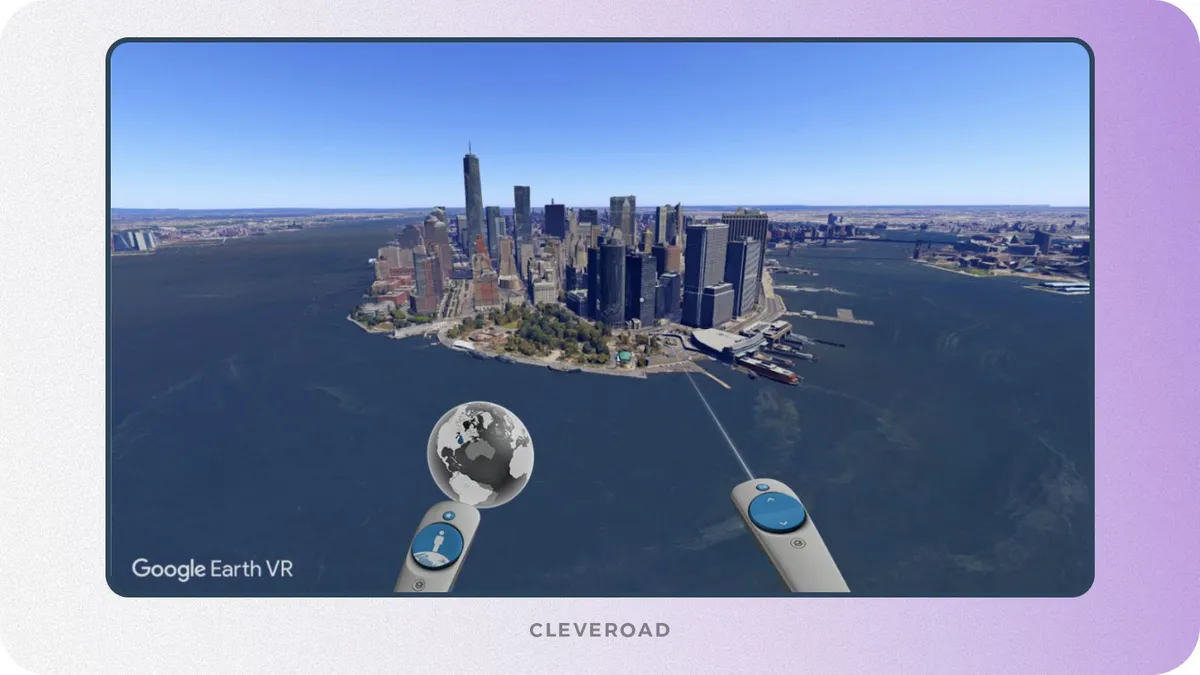
VR app development cost: Google Earth VR
Horizon Call of the Mountain
Horizon Call of the Mountain is a well-elaborated, and one of the most popular VR games set in the world of the Horizon game series. Players explore a rich, detailed environment, encounter various creatures, and engage in action-packed gameplay specifically designed for VR, including climbing mechanics, archery combat, first-person exploration, and more.
The cost of virtual reality development like Horizon typically starts at $500,000 and goes up to $2 million. Costs include advanced game design, detailed graphics and animations, complex gameplay mechanics, VR optimization, and platform-specific development.
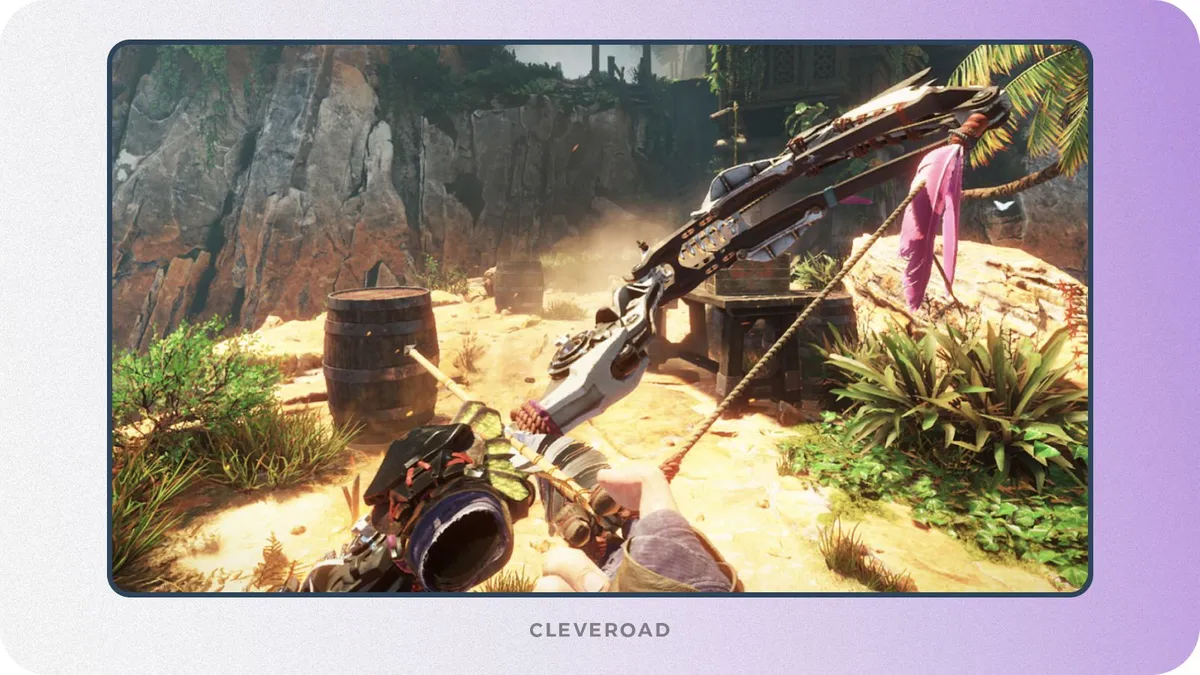
VR app development cost: Horizon Call of the Mountain
BodyVR
The Body VR is an educational VR app that immerses users in interactive simulations of human anatomy and biological processes. It allows users to explore organs, systems, and medical conditions in a virtual environment.
So, how much does it cost to build a VR app like BodyVR? Such educational VR solution price ranges from $50,000 to $200,000. Costs cover 3D modeling of anatomy, educational materials and additional content creation, interactive simulations, and development of educational framework.
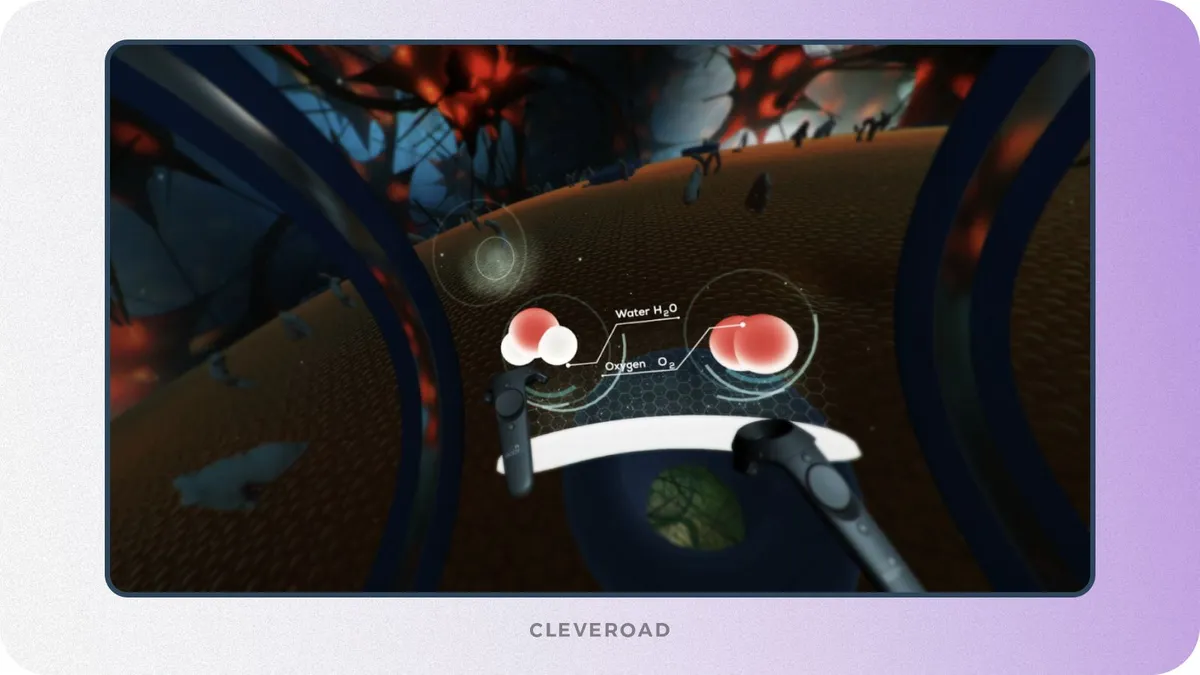
VR app development cost: BodyVR
Explore POV
Explore POV is a VR app designed exclusively for the Apple Vision Pro, is a point-of-view VR experience in various scenarios, such as exploring exotic locations, participating in extreme sports, and attending live events from a first-person perspective.
As Apple Vision Pro is a costly device itself, developing a VR app like Explore POV is considered high-end. For sure, it involves significant investment, and VR app development cost for an app like Explore POV usually range from $200,000 to $1 million or more. The factors affecting the overall costs include high-resolution content creation, advanced VR optimization, integration with Apple's unique visionOS, and the development of features, enabling users to interact with the VR environment in real-time.
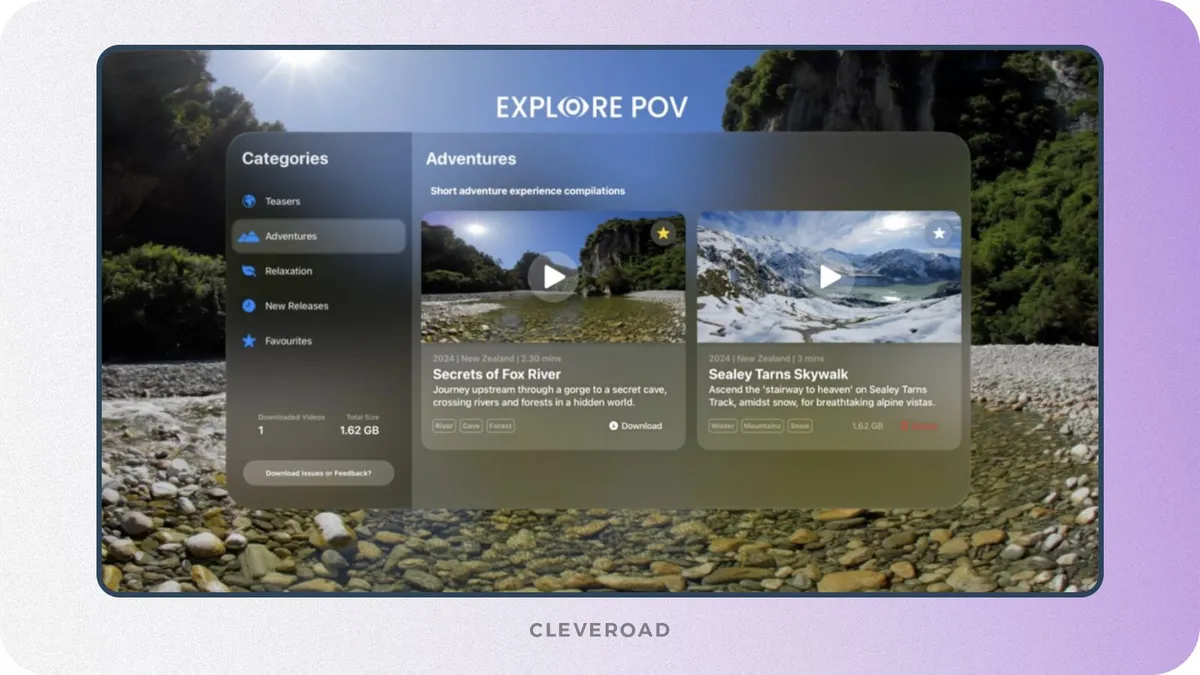
VR app development cost: Explore POV
Now you already know what to expect in terms of VR app development cost on comprehensive examples of VR solutions from different industries. However, it’s always better to directly contact an experienced IT vendor that will help you specify the estimation of your unique VR solution idea.
Development Stages and Their Impact on VR App Cost
VR game development or building of any other VR app type is much more different from ordinary app development. More resources are required, and also it requires diverse experience along with numerous professional skills. Furthermore, it requires the availability of an auxiliary device.
Let’s take a closer look at each of VR app development stages and how it may impact your virtual reality solution cost:
Step 1. Choose your VR hardware
Unfortunately, VR app cannot let you immerse in it without glasses or headsets. Hence, we should first discuss what hardware you should use before to start VR application development.
A great VR app has to be accurately optimized to run smoothly on the chosen headset to make the user experience intuitive, simple, and seamless. Here are the most currently popular options for VR headsets you can consider:
Google Cardboard
Google's cardboard device is priced around $10-$20, making it an affordable entry point for basic VR experiences. These cardboard glasses can function in tandem with Android smartphones with OS versions not older than 4.4. Also, it supports VR apps for iPhones. Currently, Google Cardboard is considered to be the easiest way to immerse in a virtual world.
Unfortunately, its low price means lower quality, so full immersion will be impossible. Due to the cheapness of hardware, solutions for Google Cardboard are categorized as lower-cost apps. And their cost starts from $5,000 to $30,000.
Apple Vision Pro
Apple Vision Pro is a high-end device with a price tag of around $3,499. This recent Apple release provides its users with vast capabilities of mixing virtual reality and augmented reality, at the same time. Besides users can enjoy the headset performance and quality thanks to the M2 chip, high-resolution display, immersive audio and laconic design.
Apple Vision Pro runs on its own operation system (visionOS), enabling businesses to create VR solutions that seamlessly integrate within the Apple ecosystem (iOS, macOS, iPadOS), adopt innovative features like spatial audio and precise tracking, and access Apple’s loyal customer base. Even though Apple Vison Pro's niche is very much untouched, the cost to create a VR application on its basis can range from $100,000 to $500,000+.
Oculus Rift S
This is a PC-tethered VR headset by Oculus, priced around $399. It features a high-resolution LCD display, inside-out tracking for easier setup, and ergonomic Oculus Touch controllers. Designed for use with a VR-ready PC, it offers access to the Oculus Store and supports immersive VR experiences with built-in audio and a comfortable halo headband design.
This is still a cost-efficient option to pick from, as it provides businesses with the ability to create solutions with wide functionality for PCs, with lower virtual reality development costs which are about $50,000 to $200,000 or more for solutions with more complex functionality.
Playstation VR (PS VR)
PlayStation VR is a virtual reality headset for PlayStation consoles, originally priced around $299-$399. It offers a mid-to-high-end VR experience. VR app development for PS VR involves creating interactive experiences that utilize the console's capabilities, often requiring a significant investment in terms of time, resources, and expertise.
Developing for PS VR can be more complex and costly compared to mobile VR platforms, but generally, it is less so than for PC-tethered headsets like the Oculus Rift S or premium options like the Apple Vision Pro. As PS VR is considered to be a mid-range platform, VR app development cost migt be around $30,000-$100,000+.
Step 2. Use a special 3D engine: Unity vs Unreal
Well, you made your choice. Great! Then, let's proceed to the development process. Now you need to figure out the availability of all required software development kits (SDKs) in 3D engines. The most popular 3D environments for building games and VR features are Unity and Unreal. They are both good, but our company prefers using Unity engine because it meets all our demands. With the help of Unity, VR development becomes much easier.
But, for example, if you just need a non-complicated mobile VR application for Cardboard, you can use only Google VR NDK for Android or VR SDK for iOS app development to create an app without using Unity Engine or another platform. However, if you are going to engage in virtual reality game development then Unity or Unreal are at your disposal.
As we already told, we consider Unity to be a more applicable engine. Moreover, paid version of Unity has an option of apps publishing in mobile stores like App Store and Google Play.
Summing up, here’s an approximate cost of virtual reality development on each 3D engine and utilizing VR NDK and Android SDK:
- Unity: Here, costs associated with the development of a VR app can range from $20,000 to $150,000 or more, depending on the complexity of the VR app, 3D assets, and required functionality set.
- Unreal Engine: Similar costs, ranging from $30,000 to $200,000+, reflecting its advanced graphics capabilities and robust toolset.
- VR SDK: Developing with a VR SDK like Oculus SDK or SteamVR SDK typically involves costs ranging from $10,000 to $50,000. This includes integrating VR-specific functionalities, optimizing for different VR platforms, and ensuring compatibility.
- VR NDK: VR NDK:For platforms that require native virtual reality mobile app development, such as Android VR NDK for Google Cardboard, overall costs can range from $20,000 to $100,000 or more. This involves low-level programming and optimization for specific hardware.
Use the most popular AR SDKs for iOS and Android. Read 8 superior AR SDK for iOS and Android that you can use right now
Step 3. UX design
While developing a VR application and its design, you should pay rapt attention to it since design means everything in your future VR app.
Some important points you should follow during the process of creating a VR app:
- Don't create too long sessions (if you develop a game). Actually, a good VR app shouldn't tire potential users, it should have an easy flow to establish seamless user experience;
- The duration of VR sessions will help users monitor the status of the battery;
- Interaction level: making VR content, provide users with a simple control panel, try not to complicate it because VR may be stressful for those who experience it for the first time;
- Devices should respond to head movements instantly - then the VR experience will be amazing;
- Users' movements should be easy - forget about abrupt acceleration and deceleration;
- Don't change the point of users' vision. Don't switch between first-person and third-person mode because it can make the user feel sick;
- Let the user customize the comfort level since each person has it's individual sensitivity to the quick motions, or somebody can be prone to nausea;
Step 4. VR UI design
First, you need to fill your virtual reality with 3D models and animation. Proprietary tools like Autodesk or Blender will help us implement this complicated VR content development stage.
Also, consider the following:
- Keep in mind to create a stereoscopic app, so render all elements properly;
- Integrate UI into the logic in interaction with 3D objects to let users feel as if they were in a real-world;
- UI should have the following scheme: it should be located in a comfortable visibility user zone, and the user won't need to move his or her head constantly;
- In mobile VR apps, the eye-tracking technology could be used. A virtual cursor tracking head motions will help users monitor the information. However, this feature should be presented optionally, to make it possible for users to disable it at any time.
In addition, when you create your own VR app, let users choose objects manually, not only using eyes. Because if your app provides a multi-level menu, for example, eye tracking can be exhausting;
The cost of UI/UX design stage in VR app development can range from $5,000 to $30,000, depending on various factors. These factors include the complexity of the virtual environment, the expertise level of the designers, the number of interactive elements, and the extent of 3D modeling required. Moreover, customization for different VR platforms and integration with VR hardware can also significantly impact the overall cost.
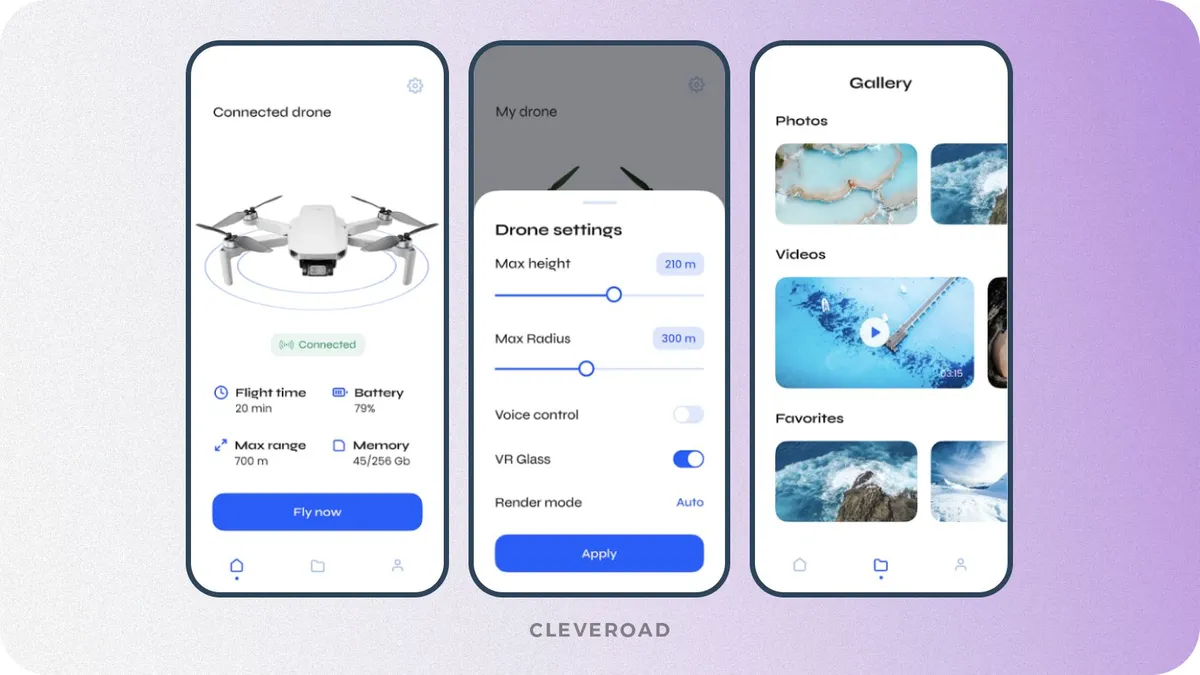
Drone app with VR goggles concept designed by Cleveroad
Step 5. VR performance optimization
While developing your VR app remember that performance optimization plays a very important role since it provides future users with the necessary comfort level.
Some performance aspects should also be noted: battery power consumption, general app performance, 3D optimization. They play an important role in a further destiny of your VR app design. Now then, what should be done to optimize it?
- The app should be optimized for 60fps. But don't test your software in Unreal or Unity environment only. Use your target device to consider the smooth process of app use;
- Use special integrated debugging tools in 3D engines. This will help you determine weak points of your app, such as lagging, for example;
- Perform batching of draw calls. To accomplish this, use special batching tools in Unity and Unreal;
- Avoid overdrawing. Consider using special auxiliary tools like Scene View Control Bar in Unity;
- Activate CPU and GPU throttling. Otherwise, it can lead to a decrease of the clock frequency.
Step 6. Testing
Testing the app is the final stage before it is released and you also have to allocate finance for this while calculating your VR app development cost. Usually, a VR app demands longer and more proper testing than an ordinary app, as virtual reality development companies note. Also, the app can be offered for user acceptance testing that helps find all bugs and fix them before the app goes to the public. Graphics engines also read the performance level of your app. Moreover, integrated testing tools will help you find bugs and any imperfections to fix them easily.
Now we will proceed to the main point of this article - how to earn on your VR app and how much money you should spend on the development of such app.
Monetizing VR app
There are some the most popular and applicable ways of monetization, let's check them out.
Freemium
Your app is available for free. But some additional services will become available only if users are ready to pay for them. For example, they need to disable advertising or add some new features. They should pay for it. This model is used in many apps and it can be profitable in case of a wise approach. Also, the freemium model will let you earn on it if you include an advertising it.
In-app purchases
This monetization model offers you some additional bonuses like new cool tools in the game or auxiliary tools in the business app that the user can buy. The cost of virtual goods may vary depending on their value in the app. This model can be added to a free app where you can get some sweets unlike others if you pay. Everything is simple.
Premium
These apps you can get only paying a certain amount of money. But when users pay initially for this app, they get it free of advertising, with all interesting and attractive add-ons and bonuses.
Advertising or product placement
Ads is the most common way of monetization in many apps that are free to use. In such apps, the user can see the different type of ads on a Homepage, during the process of use and so on. It can be rather irritating, so it is better to pay some attention to product placement. It is an unobtrusive way of advertising where various popular brands may appear in windows inside the app, on cars, devices and so on. For example, you use a real estate VR app that lets you surf the virtual house that includes furniture with IKEA label.
There is no a singular right model - everything will depend on your personal app and right marketing approach. All of them can be beneficial.
What Is Virtual Reality App Development Cost?
The final and most important point of the article is the cost. First, we would like to state that it is impossible to indicate the VR app development cost exactly. As you know, every app needs to have an MVP feature set that allows estimating the cost of this specific app - it is a fundamental truth.
It can be any app that has integrated VR features whether it be a business e-commerce app or a multiplayer game developed for the specific headset. And core features will vary depending on the app.
Indeed, it’s quite hard to confidently state your virtual reality app development cost as it heavily depends on its complexity, feature set, the platform your application runs on, etc. However, here is an answer to a question of how much does it cost to develop a VR app depending on the VR solution complexity:
- Basic VR apps requires the shortest development time and typically include, simple navigation, basic interactions, and limited 3D models with costs ranging from $20,000 to $50,000
- Medium complexity VR solutions include more advanced features like complex interactions, 3D model viewing, etc., and are usually come with a price tag between $50,000 - $80,000
- Moderately complex VR apps feature interactive environments, basic AI, realistic physics, some degree of user customization and more, costing around $80,000 - $150,000
- Advanced VR apps offer high-fidelity graphics, intricate AI, and multi-user support, taking the longest time to develop and costing upwards of $150,000 - $500,000+
Now let’s overview all main complexity levels of a VR apps in more detail:
Basic VR app
A basic VR app involves simple interactions and minimal 3D modeling. These apps are often used for introductory experiences such as virtual tours of real estate properties or museums, and basic training simulations where users can navigate through predefined environments. Simple VR apps typically involve simple navigation, basic interactions, and limited 3D models.
Medium-complexity VR app
A medium-complexity VR app steps up with more detailed 3D environments and interactive elements. These apps may incorporate features like interactive product demonstrations, educational simulations with realistic scenarios, or immersive training exercises. They often require integration with external systems such as databases or APIs to enhance user interaction and data management.
Development of medium complexity VR solutions include more advanced features like complex interactions, 3D model viewing, audio integration, and basic UI/UX design.
Advanced VR app
An advanced VR app represents the pinnacle of VR development, featuring complex 3D modeling, sophisticated interactions, and seamless integration with multiple external systems. These apps are capable of simulating intricate real-world environments, offering realistic training simulations for industries like healthcare or aviation, complex engineering design reviews, or high-fidelity virtual gaming experiences that rival console games in immersion and interactivity.
This type of app involves high-end graphics, complex interactions, advanced UI/UX design, integration with external systems (like APIs or databases), and possibly multiplayer/networking capabilities.
What Is Next?
As you can see, virtual reality app development cost consists of multiple factors that may also change depending on your own VR app concept and requirements.
On average, the approximate price of VR app development is $20,000 to $50,000 for a solution with basic functionality, $50,000 to $150,000 for a medium complexity solution, and $150,000 to $500,000+ for VR with an advanced feature set.
If you already decided to create your own VR app, order an estimate and our team will provide you with a custom VR app price estimate regarding your unique requirements and desired functionality.
Why Choose Cleveroad for VR App Development
Cleveroad is an outsourcing software development company with over 12 years of experience in providing IT services for businesses of different scales. During our practice, we’ve been successfully accomplishing software solutions delivery for various business domains including logistics, healthcare, e-commerce, EdTech, etc. Besides our team has rich experience in VR/AR solution delivery, and has deep knowledge of VR/AR app development tools including ARCore, ML Kit, integrated development environments (IDEs) like Android Studio, XCode and more.
To represent our expertise in building software with immersive technologies, we’d like to showcase one of our projects – open source Android app with AR face detection.
Our Android developers created the AR Face Detection app to contribute to the open-source AR project community. The primary goal was to share our expertise with open-source enthusiasts through this AR library. The app is designed for both AR enthusiasts and those curious about new technologies and their applications.
The project encountered several challenges, such as integrating different toolkits into the app, utilizing both frontal and rear cameras, and performing complex mathematical calculations to determine head slope degrees.
To overcome these challenges, our Android team developed an application that integrates immersive technologies to precisely track user's movements and displays an image above the user's head.
Depending on the complexity of the solution, the VR app development cost varies:
- The simplest app costs $5,000-$8,000
- Online shop costs $15,000-$25,000
- 3D games cost $50,000-$150,000
There are several popular ways to monetize your VR app:
- Freemium. The app is available for free, but users can pay for extra functionality
- In-app purchases. Users can buy virtual inventory or tools through microtransactions
- Premium. The app is available only after payment
- Advertising and product placement. Users see ads during the process of use
Currently popular and demanded VR headsets include:
- Google Cardboard
- Apple Vision Pro
- Oculus Rift S
- PlayStation VR (PS VR)
The most popular 3D environments for building games and VR features are:
- Unity
- Unreal
- Google VR NDK for Android
- VR SDK for iOS to develop an app
Unity and Unreal are both good, but our company prefers using Unity engine because it meets all our demands. With the help of Unity, VR development becomes much easier.
But if you just need a non-complicated mobile VR application for Cardboard. In that case, you can use only Google VR NDK for Android or VR SDK for iOS to develop an app.
Here are some points you should follow to create an outstanding UX design for a VR app:
- Don't create too long sessions
- Let the duration of VR sessions help users monitor the status of the battery
- Provide users with a simple control panel
- Ensure instant device response to head movements
- Cut abrupt acceleration and deceleration during VR ap use
- Make a VR app that don't change the point of users' vision
- Let the user customize the comfort level

Evgeniy Altynpara is a CTO and member of the Forbes Councils’ community of tech professionals. He is an expert in software development and technological entrepreneurship and has 10+years of experience in digital transformation consulting in Healthcare, FinTech, Supply Chain and Logistics
Give us your impressions about this article
Give us your impressions about this article